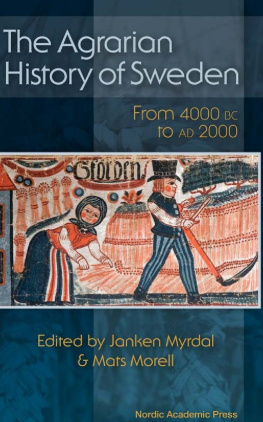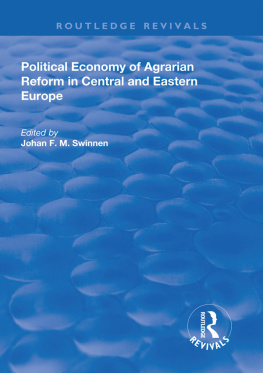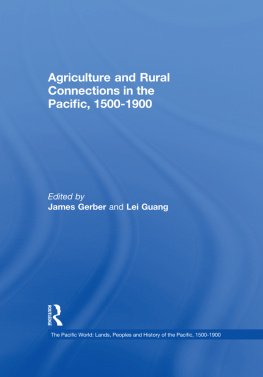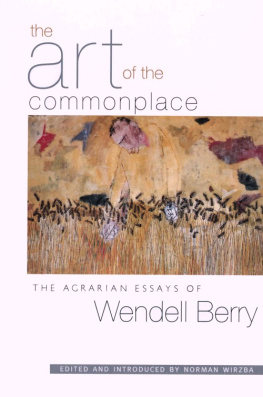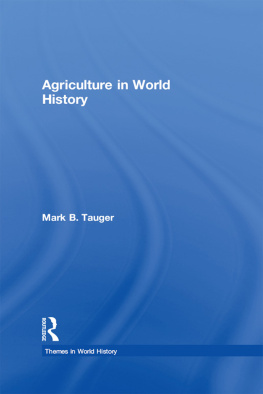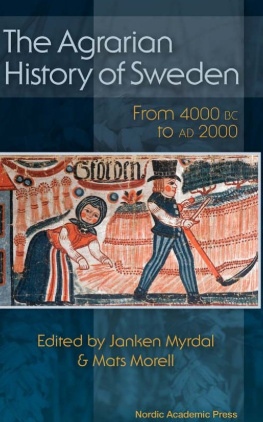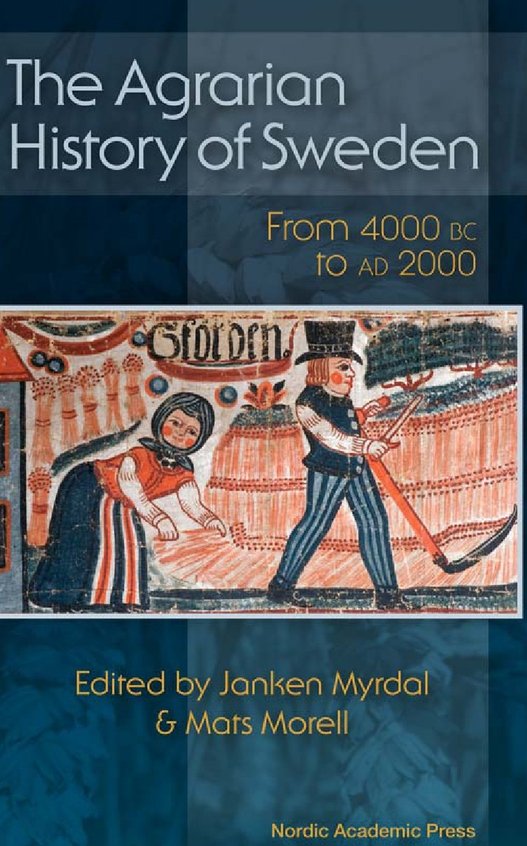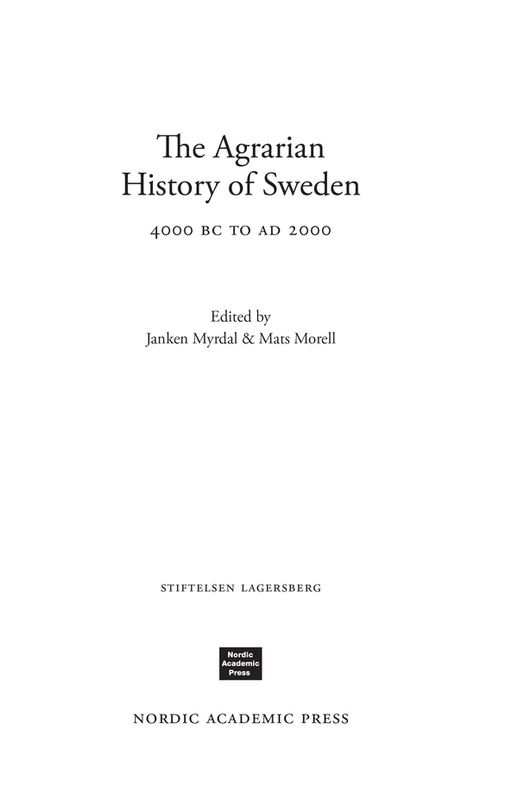The publication of this work has been realized with the generous support of Stiftelsen Lagersberg, Eskilstuna, Sweden.
Introduction
Janken Myrdal & Mats Morell
Interest in agrarian historypart of the broader history of social evolution and peoples living conditionsis growing internationally. The agrarian history of Sweden, which is presented here for an international readership, is important to this international dialogue, not least because there is an extensive research base in the country and a recent, comprehensive work on the subject, which is presented in this book in abridged form. Nordic Academic Press, in willingly shouldering the publication of this book, has made an important contribution by making Swedish history, and Swedish research, available to a wider academic audience.
This book is a compressed version of a five-volume work, Det svenska jordbrukets historia , published between 1998 and 2003. The project was prepared under the aegis of Nordiska museet, with Janken Myrdal serving as the principal editor and with seven contributing authors. Stiftelsen Lagersberg (the Lagersberg Foundation) funded the entire project, and has continued to fund the preparation of this international edition and its translation into English.
The background to the five-volume work was the growing interest in agrarian history in Sweden in the early 1990s, not least thanks to Kungliga Skogs- och Lantbruksakademien (the Royal Swedish Academy of Agriculture and Forestry, or KSLA), which in 1989 instituted a seminar on agrarian and forest history. After a couple of years, the idea of writing a standard work on Swedens agrarian history began to take form. The resultant project would run for over ten years, during which time the seminar acted as a vital sounding-board for the research required to complete the volumes. A variety of subjects that needed closer study were treated at the seminar, and the interchange between scholars from a wide range of disciplines spawned several new books along the way, with the history of cattle-farming, child labourin agriculture, and swidden cultivation (slash-and-burn agriculture) amongst the important but hitherto neglected subjects.
The five-volume work was partly inspired by the four-volume study of Danish agrarian history published in 1988 as Det danske landbrugs historie . Soon after the Swedish project began, the Norwegians were moved to write their agrarian history in a major, four-volume work, and the Finns their own in three volumes, while at the time of writing an Icelandic agrarian history is in preparation. Thus only a few years later, and after much mutual inspiration, the Nordic region now boasts no less than seventeen volumes of native agrarian history.
Initially the authors concentrated on research to fill the gaps that had already been identified, after which writing and then publication followed at a steady rate. Throughout the process there was intensive discussion on terminology and thematic treatments, and the entire work took shape in a dialogue between all the authors, yet it was never a matter of writing by committee: with at most a couple of authors per volume, each could leave their mark on the actual content. In the full-scale Swedish version, the illustrations are crucial, and the authors themselves selected and interpreted them under the guidance of an art editor. For reasons of space, most of the illustrations have had to be omitted from the English version.
For this abridged edition the authors have not merely compressed their earlier work and updated it with recent Swedish and European findings; they have in many instances shifted focus, and, more so than in the original volumes, the chapters are now closely related to developments in international agrarian research. The chapters are ordered chronologically, and each is complemented with a short overview of a more specialized theme. The ambition throughout has been to offer the broad outlines of Swedish agrarian history in a single volume. The book concludes with a synthesis of the entire work and reflections on the course of Swedish agrarian development and historical research against an international background. There is also an appendix with statistical data concerning primarily the early modern period onwards, and a bibliography of the most important works in the field, with particular focus on research published in the last decade. The aim of this book is to offer readersbe they students, general readers, those of Swedish descent, or professional agrarian historiansa comprehensive, logically arranged, and lucid introduction to Swedens oldest industry. Readers who wish to pursueany particular issue will find plenty of suggestions for further reading in the notes and bibliography.
Even if the agrarian population and the circumstances of agricultural production are the heart of the book, it is inevitable that, faced with six thousand years of history, the importance of the various themes will vary considerably according to the period under discussion, and that there will be some overlap between periods. Choosing a terminology that holds good for all agesand chaptersis a delicate matter, and was the source of lively debate between the authors in the preparation of the Swedish version. With translation came new excitement, for the agrarian history of each country has produced a series of specific terms, often legally or socially defined, on which developments in historiography largely depend. Many are resistant to translation. We have Britains customary tenant and Swedens skattebonde ; Norways odelsrett and Denmarks grdmand . These problems are rarely insurmountable, given that the similarities are often greater than the individual terms might lead us to think, but in some instances the terminological variations reflect very real differences in meaning: translating the Swedish bonde into English is always a challenge, for it does not always equate with peasant . We have used English terminology as far as possible, but have elaborated on the original Swedish terms wherever their precise meaning is important to our argument.
Both the five-volume edition and the condensed, updated version presented here are part of a wider trend that in recent years has seen agrarian and rural history become lively fields of European research. It is part and parcel of this that their historiography has become a subject in its own right. Indeed, two important works have recently been published that together treat agrarian historiography for much of Europe: The Rural History of Medieval European Societies and Rural History in the North Sea Area .
The beginnings of agrarian history in Sweden
The publication of books and pamphlets in Sweden accelerated from the 1730s onwards, and among the major beneficiaries of this explosion were agricultural texts. The 1770s saw a further increase, when the first large works on Swedish agrarian history were also published. Shorterreferences to the history of agriculture were made in several books published in the late eighteenth century, its inclusion primarily justified on the grounds of political and economic utility. A utilitarian focus, and above all the rancorous debate on contemporary agrarian policy, was central to the hundred-page epic, Landtbrukets den i Sverige (The fate of farming in Sweden), published in 1776 by the lawyer and librarian Fredrik Mozelius in the proceedings of the Royal Patriotic Society. As he wrote in his introduction, In the present century, philosophical as it is rightly called, the history of its industries has, as it were, been instilled with life since the founding of scientific and agricultural societies in the majority of European countries. Engelbert Jrlin, a farmers son, who in 1777 published an even longer text in the same series, departed from the narrow utilitarian trend. A disciple of Linnaeus, he had a predilection for scientific systematization, and attempted to compile evidence of the types of animals and cereals that had been farmed since the Middle Ages. At the end of the eighteenth century, Magnus Blix, judge and controversialist, published his polemic Swenska jordbrukets historia i kortaste sammandrag (Swedish agricultural history in briefest outline). Blix argued that Swedish agriculture was in decline, and drew a number of salutary lessons from France, where in his view the Revolution had been made possible by a similar degeneration. Some years later he was countered by Pehr Nylandh, a land-surveyor, who defended the recent large-scale redistribution of land and other measures taken by the Swedish state to improve agriculture.

